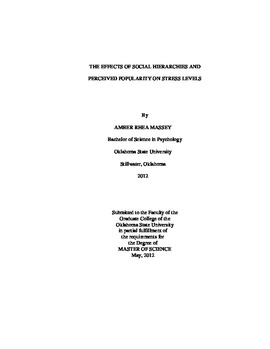| dc.contributor.advisor | Byrd-Craven, Jennifer | |
| dc.contributor.author | Massey, Amber Rhea | |
| dc.date.accessioned | 2014-04-15T22:23:51Z | |
| dc.date.available | 2014-04-15T22:23:51Z | |
| dc.date.issued | 2012-05-01 | |
| dc.identifier.uri | https://hdl.handle.net/11244/9442 | |
| dc.description.abstract | The purpose of this research is discovering a better understanding of the relationship between social hierarchies and stress levels in adolescents. This study uses a non-invasive approach (saliva samples) in order to assess salivary cortisol to reflect stress responses in a high school setting. Perceived popularity was studied in order to determine social hierarchical rankings and determinates for social positioning. Stress responses was studied both in a naturalistic setting as well as in an experimental setting (a reward allocation task). The research attempts to investigate what makes individuals socially dominant or subordinate and what role stress responses play in these hierarchies. The current results have implications for early intervention in social bullying as well as health consequences related to stress levels in teens. The study shows that the more popular the individual is the more bistrategic strategies they use. The popular individuals were high in prosocial and coercive strategies as well as high in extraversion. In addition, coercive strategies were related to parent's income. The study also showed there is a cortisol difference between the sexes with females having higher overall cortisol. In addition, dominant females had the highest cortisol through the reward allocation task and dominant females won the game most often. However, the study showed that after they won that their cortisol level began to drop. Cortisol levels were also highest for dominant females upon entering the lunchroom. Overall, dominant individuals had the highest cortisol scores and changes between cortisol scores. Subordinate individuals did not have large change scores and therefore were viewed as having less stress in the task. The findings suggest that perceived popularity and social status is related to stress level and this is especially seen in females. | |
| dc.format | application/pdf | |
| dc.language | en_US | |
| dc.publisher | Oklahoma State University | |
| dc.rights | Copyright is held by the author who has granted the Oklahoma State University Library the non-exclusive right to share this material in its institutional repository. Contact Digital Library Services at lib-dls@okstate.edu or 405-744-9161 for the permission policy on the use, reproduction or distribution of this material. | |
| dc.title | Effects of Social Hierarchies and Perceived Popularity on Stress Levels | |
| dc.type | text | |
| dc.contributor.committeeMember | Kennison, Shelia | |
| dc.contributor.committeeMember | Grant, DeMond | |
| osu.filename | Massey_okstate_0664M_12018.pdf | |
| osu.college | Arts and Sciences | |
| osu.accesstype | Open Access | |
| dc.description.department | Department of Psychology | |
| dc.type.genre | Thesis | |
| dc.subject.keywords | perceived popularity | |
| dc.subject.keywords | social hierarchies | |
| dc.subject.keywords | stress | |
